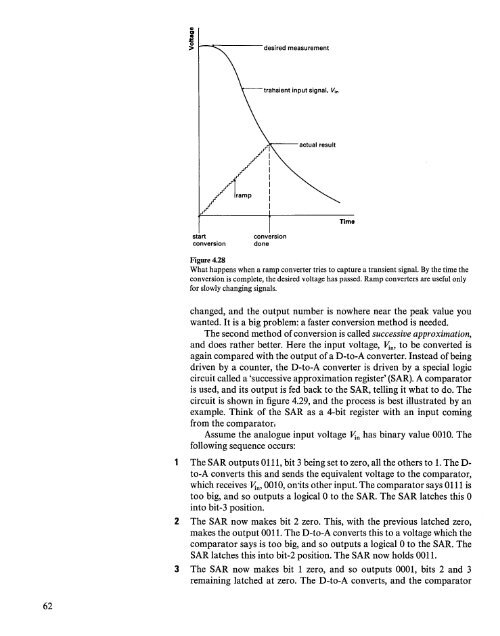Microcomputer Circuits and Processes
Microcomputer Circuits and Processes
Microcomputer Circuits and Processes
Create successful ePaper yourself
Turn your PDF publications into a flip-book with our unique Google optimized e-Paper software.
II<br />
CI<br />
l!<br />
~L--~---- desired measurement<br />
trahsient<br />
input signal. V in<br />
.x---actual<br />
result<br />
Time<br />
start<br />
conversion<br />
conversion<br />
done<br />
Figure 4.28<br />
What happens when a ramp converter tries to capture a transient signal. By the time the<br />
conversion is complete, the desired voltage has passed. Ramp converters are useful only<br />
for slowly changing signals.<br />
changed, <strong>and</strong> the output number is nowhere near the peak value you<br />
wanted. It is a big problem: a faster conversion method is needed.<br />
The second method of conversion is called successive approximation,<br />
<strong>and</strong> does rather better. Here the input voltage, ~n, to be converted is<br />
again compared with the output of a D-to-A converter. Instead of being<br />
driven by a counter, the D-to-A converter is driven by a special logic<br />
circuit called a 'successive approximation register' (SAR). A comparator<br />
is used, <strong>and</strong> its output is fed back to the SAR, telling it what to do. The<br />
circuit is shown in figure 4.29, <strong>and</strong> the process is best illustrated by an<br />
example. Think of the SAR as a 4-bit register with an input coming<br />
from the comparator:<br />
Assume the analogue input voltage ~n has binary value 0010. The<br />
following sequence occurs:<br />
1 The SAR outputs 0111, bit 3 being set to zero, all the others to 1. The D-<br />
to-A converts this <strong>and</strong> sends the equivalent voltage to the comparator,<br />
which receives ~m 0010, onits other input. The comparator says 0111 is<br />
too big, <strong>and</strong> so outputs a logical 0 to the SAR. The SAR latches this 0<br />
into bit-3 position.<br />
2 The SAR now makes bit 2 zero. This, with the previous latched zero,<br />
makes the output 0011. The D-to-A converts this to a voltage which the<br />
comparator says is too big, <strong>and</strong> so outputs a logical 0 to the SAR. The<br />
SAR latches this into bit-2 position. The SAR now holds 0011.<br />
3 The SAR now makes bit 1 zero, <strong>and</strong> so outputs 0001, bits 2 <strong>and</strong> 3<br />
remaining latched at zero. The D-to-A converts, <strong>and</strong> the comparator<br />
62











